Objective To study the recovery and mechanism of nerve root under variable chronic injury and to determine the alerting index of the evoked potential of the irreversible injury to the nerve root, so as to offer the evidence for selecting treatment methods, judging prognosis and grasping treatment juncture.Methods Autogenous cancellous bones were planted into the right C7-8 and C8T1 intervertebral foramens in 30 cats with weight 3-5 kg to make chronicinjury models. The left side was for auto-contrast. By 24 weeks’ observation anddynamic supervisory of evoked potential, the injury degrees were ascertained and classified into Ⅰto Ⅴdegree groups. Then the operation of decompression was performed on every group. During the following 32 weeks, the evoked potential survey and pathological tissue examination were made every week to observe the function recovery of the injured roots.Results The tissue form and functionof the nerve roots with ⅠandⅡdegree injuries recovered well within 2 to 6 weeks. Those with Ⅲ degree injury began to recover in the 4th week, and graduallyrecovered to normal 12 weeks later. In the group of Ⅳ degree injury, the recoverywas slow. They could recover completely in 3 of 6 cats, partly in 2 and hardly recovered in 1. The function and tissue form of nerve roots with Ⅴdegree injury could hardly recovered. Conclusion In the case that the compression has been removed before the nerve roots suffer Ⅲ degree injury. The tissue form and function of the nerve roots will recovered satisfactorily, whereas they may suffer irreversibly injury by Ⅳdegree injury, and even can hardly recover by Ⅴdegree injury. During the supervisory process of the recovery of the injured nerve roots, sensitive evoked potential is a sensitive sign of early recovery and motion evoked potential is a reliable sign of recovery extent.
Citation: YANG Dazhi,WANG Kunzheng,CHEN Junchang,et al.. RECOVERY AND EVOKED POTENTIAL OF NERVE ROOT UNDER VARIABLE CHRONICINJURY. Chinese Journal of Reparative and Reconstructive Surgery, 2004, 18(5): 414-419. doi: Copy
Copyright © the editorial department of Chinese Journal of Reparative and Reconstructive Surgery of West China Medical Publisher. All rights reserved




